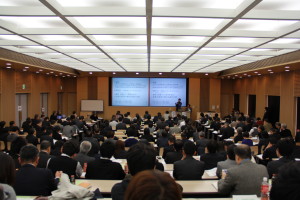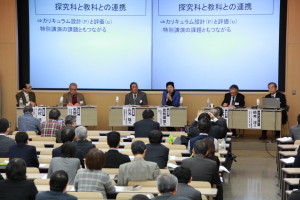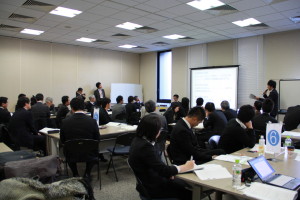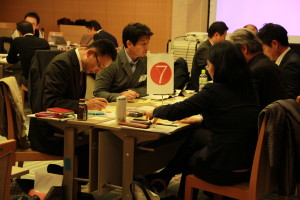Event Outline
The 12th High School-University Collaboration Education Forum
 University entrance examinations are deeply connected to a country’s school system and social structure. In Japan, academic ability tests are based on the premise that a common educational curriculum is established nationwide, and test questions must be published for the first time and after the fact. However, these are things that are unique to Japan when viewed from a global perspective. In the current entrance examination reform, discussions are underway on the possibility of holding the common test multiple times, grading the exam, introducing item response theory (IRT), and using computers. I would like to consider the realistic possibility of an “achievement test” (provisional name), including these various issues.
University entrance examinations are deeply connected to a country’s school system and social structure. In Japan, academic ability tests are based on the premise that a common educational curriculum is established nationwide, and test questions must be published for the first time and after the fact. However, these are things that are unique to Japan when viewed from a global perspective. In the current entrance examination reform, discussions are underway on the possibility of holding the common test multiple times, grading the exam, introducing item response theory (IRT), and using computers. I would like to consider the realistic possibility of an “achievement test” (provisional name), including these various issues.
| schedule | Friday, December 5, 2014 9:30-17:15 | |
| venue | Campus Plaza Kyoto | |
| theme | High school-university transition and academic ability development: Thinking about achievement tests (provisional name) | |
| Sponsored by | Kyoto High School-University Collaborative Research Council (Kyoto Prefectural Board of Education/Kyoto City Board of Education/Kyoto Prefectural Association of Private Junior and Senior High Schools/Kyoto Chamber of Commerce and Industry/University Consortium Kyoto, a public interest incorporated foundation) | |
| Capacity | Keynote speeches, special lectures, and case studies | 200 people (first come first served) |
| Subcommittee 1.2.3.4 | 30 people each (first come first served) | |
| Application acceptance | October 7, 2014 (Tuesday) 12:00 to November 21, 2014 (Friday) 17:00 | |
| Participation fee | High school and university related people in Kyoto Prefecture | 1,000 yen |
| Anyone other than those mentioned above (including corporate participants within Kyoto Prefecture) | 2,000 yen | |
12th High School-University Collaboration Forum Leaflet ![]()
(Part 1) 9:30-14:45 Keynote speech, special lecture, and practical case studies
| Opening remarks : 9:30-9:35 |
Satoshi Kitamura (Chairman of the Steering Committee of the Kyoto High School-University Collaboration Research Council / Principal of Kyoto Gaidai Nishi High School) | |
| Keynote report 9:35-9:45 |
Hiroyuki Nakamura (Professor, Kyoto Bunkyo University Faculty of Clinical Psychology, University Consortium Kyoto High School-University Collaboration Promotion Office) | |
| Special lecture 9:45-10:35 |
“Can the Japanese culture of university entrance examinations be changed? – Considering the achievement test (tentative title) -” Speaker: Katsuhiro Arai (Vice Director, National Center for University Entrance Examinations) Chair: Iwako Yamamoto (Associate Professor, Kyoto High School-University Collaboration Promotion Office, University Consortium/Kyoto Institute of Technology Admissions Center) |
|
| Practical case studies: 10:45-12:15 | ■ Osaka Prefectural Education Center Attached High School Theme: Practice of “Tankyu Navi” at Osaka Prefectural Education Center Attached High School – New “learning” starts here. – Reporter: Rika Onchi (Vice Principal of Osaka Prefectural Education Center Attached High School) Reporter: Satoshi Yamamoto (Principal and Head of the Research Department at Osaka Prefectural Education Center Attached High School) |
|
| Our school is located next to the Osaka Prefectural Education Center, the academic research hub of Osaka Prefecture, and we practice education integrated with the research and training functions of the center. In this forum, we will report on the practice of “Tsukuyunabi,” the pillar of our educational activities. In the first year, we “connect with people,” in the second year, we “connect with society,” and in the third year, we “open up the future.” Through activities that foster ideas and cooperation, such as “drama creation,” and town development activities such as “Abiko Exploration,” we are cultivating “people who can open up their own paths.” | ||
| ■ Takasaki University of Economics Theme: Takasaki University of Economics + Takasaki University of Economics “High School-University Collaborative Seminar” – An attempt at two-way high school-university collaboration Presenter: Shuichi Yano (Professor at Takasaki University of Economics / Advisor at Takasaki University of Economics High School) |
||
| The high school-university collaborative seminar is a group study that specifically studies the overseas strategies of Japanese companies. After a series of presentations and discussions, students visit the Tokyo headquarters and conduct interviews. High school students not only acquire knowledge and presentation skills, but also find role models in the university students who act as tutors and business people working at the forefront of the economy. Through this opportunity to meet, the collaborative seminar allows them to reaffirm the meaning of “learning” and to make independent choices about their future career paths. University students also learn through teaching. Ultimately, it also serves as a rehearsal for job hunting. | ||
| ■ Kyoto Institute of Technology Theme: Kyoto Institute of Technology’s “Da Vinci Entrance Exam” – What and how do we measure in the test? – Presenter: Hiroshi Uchimura (Director of the University Consortium Kyoto High School-University Collaboration Promotion Office / Professor at the Kyoto Institute of Technology Admissions Center) |
||
| The academic abilities required in the coming age will be as follows: 1) Incorporating new knowledge into the network of knowledge already learned. 2) Rather than memorizing a single correct answer, it will be required to utilize and express knowledge. 3) Communication skills to learn from each other are also important! In this presentation, I will explain the theoretical background of the above ideas, and then introduce the Da Vinci entrance exam as an example of an exam designed to measure such academic abilities. |
||
| Moderator: Iwako Yamamoto (Associate Professor, Kyoto High School-University Collaboration Promotion Office, University Consortium/Kyoto Institute of Technology Admissions Center) | ||
| [Break] 12:15-13:15 | ||
| Discussion 13:15~14:45 |
Coordinator: Hiroshi Mukumoto (University Consortium Kyoto High School-University Collaboration Promotion Office/Lecturer, Faculty of Science and Engineering, Ritsumeikan University) | |
(Part 2) 15:15-17:15 Breakout session
| Subcommittee 1 [Expression Techniques] |
Theme: Practice of label work as lesson reflection Presenter 1: Joji Nakaji (Teacher, Keio Shiki High School) Presenter 2: Shin Hasegawa (Associate Professor, Faculty of Commerce, Kansai University) Coordinator: Yoichi Tsutsui (University Consortium Kyoto High School-University Collaboration Promotion Office / Professor, Faculty of Humanities, Kyoto Seika University) |
|
| In education up until now, teachers have mainly taught students knowledge and correct answers. However, as a result of rapid changes in society and the gradual obsolescence of knowledge, the accumulation of knowledge itself has become less meaningful, and students are no longer able to respond when faced with a problem that has no correct answer. Therefore, what is desired in the future is education that allows students to be aware of how much they have understood (class reflection). Reflection not only confirms past processes, but also creates guidelines for the future. The speaker has been introducing label work into his classes as a method to visualize reflection for many years. The lecture will focus on practical work by the instructor so that participants can introduce it into their classes. | ||
| Subcommittee 2 [Mathematics] |
Theme: Introduction of teaching materials incorporating mathematical activities through high school-university collaboration and practical report Presenter 1: Kazuma Matsuda (Teacher at Kyoto Prefectural Nanyo High School ) Presenter 2: Takeshi Fukao (Associate Professor at Kyoto University of Education) Coordinator: Hidefumi Toyama (Director of High School Education Division, Guidance Department, Kyoto Prefectural Board of Education) |
|
| The new curriculum guidelines emphasize “mathematical activities,” and although many textbooks have added “problem-based learning,” many aspects are still left to the discretion of the teacher. The curriculum guidelines define mathematical activities as “finding a problem on one’s own, planning a solution, considering and processing it, reflecting on the process and considering the significance of the results obtained and developing it further,” “connecting what has been learned to life and using it to consider concrete phenomena,” and “expressing one’s own ideas mathematically, clarifying the reasons for them, explaining them, and discussing them.” While reviewing the previously learned content, we will introduce teaching materials that are centered on these activities and report on our practice. In particular, we would like to note that by incorporating prediction activities, students can realize the usefulness of mathematics and deepen their understanding of the connection between mathematics and science. In this subcommittee, we would like to discuss further possibilities of “mathematical activities” based on the practice report. |
||
| Subcommittee 3 [English] |
Theme: Guidance and evaluation aimed at developing English communication skills with an emphasis on expressiveness Speaker 1: Yuko Kunimatsu (Teacher at Kyoto Municipal Saikyo High School ) Speaker 2: Emiko Izumi (Professor at Kyoto University of Education) Coordinator: Yoko Oyama (Director of School Guidance Division, Guidance Department, Kyoto City Board of Education) |
|
|
At Kyoto City Saikyo High School, in order to promote the improvement of practical English skills that can be used in the real world, we have been promoting the development of communicative communication skills by providing many opportunities for speeches, presentations, discussions, debates, etc. in school-set subjects. Since last year, we have been working on activities and performance evaluations aimed at the comprehensive development of the four skills in Communication English I and II. At the university, we are providing instruction and evaluation aimed at developing communication skills in order to cultivate global citizens who can contribute and play an active role in the global society. We aim to acquire usable English by internalizing the language by reading aloud and shadowing what we have read and heard about current affairs, and by summarizing, discussing, and making presentations. Through each initiative at high school and university, we will consider instruction and evaluation for the development of communicative communication skills from the perspective of high school-university connection. |
||
| Subcommittee 4 [Science] |
Theme: Science activities at Ryukoku University Heian High School through high school-university collaboration Speaker 1: Kazuya Nakajima (Teacher at Ryukoku University Heian High School) Speaker 2: Manabu Fujiwara (Professor at the Faculty of Science and Technology, Ryukoku University) Coordinator: Hisao Hayashi (Professor at the Faculty of Science and Technology, Ryukoku University / Director of the Ryukoku University High School-University Collaboration Promotion Office) |
|
| In the course for students who wish to enter the Faculty of Science and Technology of Ryukoku University through the Affiliated School Recommendation Entrance Examination, we are working on two science-related projects in collaboration with the university in the third year of high school, and we will report on these projects. One is a class called “Science and Mathematics Research (Science)” in the regular curriculum. The main content is two consecutive hours of experiments on physics and chemistry, the submission of reports, a presentation of students’ research (one theme from the experiment), and a special class by a university professor (one person). The other is a “Science Book Report” in the extracurricular program. This is made three times, but in the second time, students go to the university’s open campus, receive direct one-on-one guidance from five university professors, and participate in the open laboratory of the Faculty of Science and Technology. Through these, students are able to acquire the basic knowledge and skills of physics and chemistry necessary in high school, without being bound by entrance exam studies, and to develop the scientific thinking and expression skills necessary after entering university, and to arouse their interest and motivation in specialized fields. |
||
Application
Application period: Tuesday, October 7, 2014, 12:00 – Friday, November 21, 2014, 17:00
*If your browser’s cookies are not enabled, you may not be able to apply.
*Each subcommittee has a limited number of participants, so you cannot change your number after completing the application process.
*Please apply if you are sure you will attend. Applications cannot be accepted on the day of the event.
Implementation Report
On the day, about 200 people, including high school teachers and university faculty from all over Japan, participated in the event.
In the first part, Deputy Director Arai of the National Center for University Entrance Examinations gave a lecture on the background and issues of the recent university entrance examination reform, followed by reports on the current state of practice from high schools and universities that are putting new “learning” practices into practice. After that, there was a break and a Q&A session and discussion using comment papers from the floor. In particular, during the discussion, a lively debate was held between Deputy Director Arai and Mr. Katsumi Arase (temporary member of the Central Council for Education’s High School-University Transition Special Committee) on the Central Council for Education’s proposed report, providing an opportunity for participants to deepen their knowledge of the significance and background of the new university entrance examination system.
In the second part, the event was divided into four subcommittees, where participants from high schools and universities gave case presentations, after which they exchanged opinions and shared information in groups.
The 13th High School-University Collaboration Education Forum is scheduled to be packed with content, so we hope you will participate.
The resume, materials, and PowerPoint data from the 12th High School-University Collaboration Education Forum can be found here.
| Part 1 | keynote report | Report materials | |
| special lecture | Can the Japanese culture of university entrance examinations be changed? – Considering achievement tests (provisional name) |
Presentation materials | |
| Practical case studies | Osaka Prefectural Education Center High School’s “Tankyu Navi” Practice – New “learning” starts here. |
Report materials | |
| Report material 2 | |||
| Takaoka University of Economics + Takaoka University of Economics “High School-University Collaborative Seminar” – An Attempt at Two-Way High School-University Collaboration |
Report materials | ||
| Report material 2 | |||
| Kyoto Institute of Technology’s “Da Vinci Entrance Exam” – What does the test measure and how? – |
Report materials | ||
| Report material 2 | |||
| discussion | Materials | ||
| Part 2 | Subcommittee 1 | [Expression Technique] Label work practice as a lesson reflection | Report material 1 |
| Report material 2 | |||
| Report material 3 | |||
| 2nd subcommittee | [Mathematics] Introduction of teaching materials incorporating mathematical activities through collaboration between high schools and universities and a practical report | Report material 1 | |
| Report material 2 | |||
| Report material 3 | |||
| Report material 4 | |||
| Subcommittee 3 | [English] Instruction and assessment aimed at developing English communication skills with an emphasis on expressiveness | Report material 1 | |
| Report material 2 | |||
| Report material 3 | |||
| 4th Subcommittee | [Science] Science initiatives at Ryukoku University Heian High School through high school-university collaboration | Report material 1 | |
| Report material 2 |





















